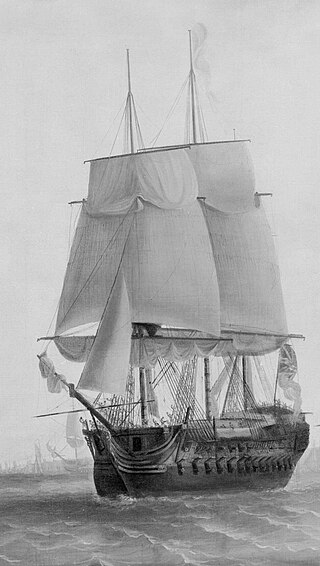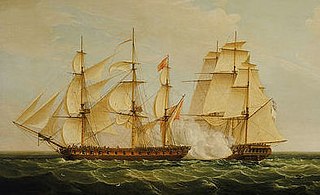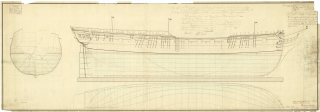
The second USS Boston was a 24-gun frigate, launched 3 June 1776 by Stephen and Ralph Cross, Newburyport, Massachusetts, and completed the following year. In American service she captured a number of British vessels. The British captured Boston at the fall of Charleston, South Carolina, renamed her HMS Charlestown, and took her into service. She was engaged in one major fight with two French frigates, which she survived and which saved the convoy she was protecting. The British sold Charlestown in 1783, immediately after the end of the war.

HMS Polyphemus, a 64-gun third-rate ship of the line of the Royal Navy, launched on 27 April 1782 at Sheerness. She participated in the 1801 Battle of Copenhagen, the Battle of Trafalgar, and the Siege of Santo Domingo. In 1813 she became a powder hulk and was broken up in 1827.

HMS Speedy was a 14-gun Speedy-class brig of the British Royal Navy. Built during the last years of the American War of Independence, she served with distinction during the French Revolutionary Wars.

Courageux was a 74-gun ship of the line of the French Navy, launched in 1753. She was captured by the Royal Navy in 1761 and taken into service as HMS Courageux. In 1778 she joined the Channel Fleet, and she was later part of the squadron commanded by Commodore Charles Fielding that controversially captured a Dutch convoy on 31 December 1779, in what became known as the Affair of Fielding and Bylandt. On 4 January 1781, Courageux recaptured Minerva in a close-range action west of Ushant that lasted more than an hour. That April, Courageux joined the convoy under George Darby which successfully relieved the Great Siege of Gibraltar.

HMS Argo was a 44-gun fifth-rate Roebuck-class ship of the Royal Navy. She was launched in 1781 from Howdon Dock. The French captured her in 1783, but 36 hours later the British recaptured her. She then distinguished herself in the French Revolutionary Wars by capturing several prizes, though she did not participate in any major actions. She also served in the Napoleonic Wars. She was sold in 1816.
Admiral Sir Lawrence William Halsted GCB was an officer of the Royal Navy who served during the American War of Independence and the French Revolutionary and Napoleonic Wars.

The Java campaign of 1806–1807 was a minor campaign during the Napoleonic Wars by British Royal Navy forces against a naval squadron of the Kingdom of Holland, a client state of the French Empire, based on the island of Java in the Dutch East Indies. Seeking to eliminate any threat to valuable British merchant convoys passing through the Malacca Straits, Rear-Admiral Sir Edward Pellew determined in early 1806 that the Dutch naval forces based at Java, which included several ships of the line and three frigates, had to be defeated to ensure British dominance in the region. Lacking the forces to effect an invasion of the Dutch colony, Pellew instead sought to isolate and blockade the Dutch squadron based at Batavia in preparation for raids specifically targeting the Dutch ships with his main force.
Rear-Admiral James Walker CB, CvTE was an officer of the Royal Navy. He served during the American War of Independence, and the French Revolutionary and Napoleonic Wars.

The action of 7 April 1800 was a minor naval engagement fought between a British squadron blockading the Spanish naval base of Cádiz and a convoy of 13 Spanish merchant vessels escorted by three frigates, bound for the Spanish colonies in the Americas. The blockade squadron consisted of the ships of the line HMS Leviathan and HMS Swiftsure and the frigate HMS Emerald, commanded by Rear-Admiral John Thomas Duckworth on Leviathan. The Spanish convoy sailed from Cádiz on 3 April 1800 and encountered Duckworth's squadron two days later. The Spanish attempted to escape; Emerald succeeded in capturing one ship early on 6 April. The British captured a brig the following morning and the British squadron divided in pursuit of the remainder.
Censeur was a 74-gun Pégase-class ship of the line of the French Navy, launched in 1782. She served during the last months of the American War of Independence, and survived to see action in the French Revolutionary Wars. She was briefly captured by the British, but was retaken after a few months and taken back into French service as Révolution. She served until 1799, when she was transferred to the Spanish Navy, but was found to be rotten and was broken up.

HMS Sibyl was a 28-gun Enterprise-class sixth-rate frigate of the Royal Navy. Sibyl was renamed HMS Garland in 1795.

Rear-Admiral John Bligh CB was an officer in the Royal Navy who served during the American War of Independence and the French Revolutionary and Napoleonic Wars.

HMS Swallow was a Cruizer-class brig-sloop launched in December 1805, nine months late. She served the Royal Navy through the Napoleonic Wars, capturing numerous privateers. After the end of the wars she was broken up in 1815.

HMS Pearl was a fifth-rate, 32-gun British Royal Navy frigate of the Niger-class. Launched at Chatham Dockyard in 1762, she served in British North America until January 1773, when she sailed to England for repairs. Returning to North America in March 1776, to fight in the American Revolutionary War, Pearl escorted the transports which landed troops in Kip's Bay that September. Much of the following year was spent on the Delaware River where she took part in the Battle of Red Bank in October. Towards the end of 1777, Pearl joined Vice-Admiral Richard Howe's fleet in Narragansett Bay and was still there when the French fleet arrived and began an attack on British positions. Both fleets were forced to retire due to bad weather and the action was inconclusive. Pearl was then despatched to keep an eye on the French fleet, which had been driven into Boston.
The Battle of the Levant Convoy was a naval engagement of the French Revolutionary Wars fought on 7 October 1795. During the battle, a powerful French squadron surprised a valuable British convoy from the Levant off Cape St Vincent on the coast of Portugal. The convoy was weakly defended, and although the small escort squadron tried to drive the French back, they were outmatched. In the ensuing action one of the British ships of the line and almost the entire convoy was overrun and captured. The French commander, Commodore Joseph de Richery, then retired to the neutral Spanish port of Cádiz, where he came under blockade.

Richery's expedition was a French naval operation during 1795 and 1796 as part of the French Revolutionary Wars. The operation was led by Commodore Joseph de Richery and comprised two separate cruises; the first was an operation off Cádiz in Southern Spain in which Richery attacked and defeated a large British merchant convoy with a weak escort, taking many prizes. Forced to anchor at Cádiz, the French squadron was subsequently blockaded in the port for almost a year. Richery was enabled to escape in August 1796 by a Spanish fleet, and went on to attack British fisheries off Newfoundland and Labrador before returning to France having inflicted severe damage to British Atlantic trade.

HMS Romulus was a 36-gun fifth rate frigate of the Flora class, built for the Royal Navy and launched in September 1785. At the outbreak of the French Revolutionary War, Romulus was despatched to the Mediterranean where she joined a fleet under Admiral Lord Hood, initially blockading, and later occupying, the port of Toulon. She played an active role during the withdrawal in December, providing covering fire while HMS Robust and HMS Leviathan removed allied troops from the waterfront.

HMS Artois was a fifth-rate Artois-class frigate of the Royal Navy, designed by Sir John Henslow and launched in 1794 at Rotherhithe as the lead ship of her class. She served for the majority of her career in the English Channel under the command of Edmund Nagle in the squadrons of Edward Pellew and John Borlase Warren, notably taking part in the action of 21 October 1794 where she captured the 44-gun frigate La Révolutionnaire almost singlehandedly. She participated in a number of other actions and events including the attempted invasion of France in 1795. Artois continued to serve actively on the coast of France in blockade and patrolling roles, taking a large number of ships as prizes, until she was wrecked with no loss of life off Île de Ré on 31 July 1797 while attempting to reconnoitre the harbour of La Rochelle.

HMS Caroline was a 36-gun fifth-rate Phoebe-class frigate of the Royal Navy. She was designed by Sir John Henslow and launched in 1795 at Rotherhithe by John Randall. Caroline was a lengthened copy of HMS Inconstant with improved speed but more instability. The frigate was commissioned in July 1795 under Captain William Luke to serve in the North Sea Fleet of Admiral Adam Duncan. Caroline spent less than a year in the North Sea before being transferred to the Lisbon Station. Here she was tasked to hunt down or interdict French shipping while protecting British merchant ships, with service taking her from off Lisbon to Cadiz and into the Mediterranean Sea. In 1799 the ship assisted in the tracking of the French fleet of Admiral Étienne Eustache Bruix, and in 1800 she participated in the blockade of Cadiz.
Admiral Thomas Le Marchant Gosselin was a British naval officer of the 18th and 19th centuries who received the patronage of senior officers such as Samuel Hood, 1st Viscount Hood and William Cornwallis. Gosselin joined the Royal Navy in 1778 and as a junior officer had extensive service in the American Revolution, including participating in the Battle of the Saintes in April 1782. Promoted to commander in April 1793, Gosselin took part in the Glorious First of June as commander of HMS Kingfisher. He was promoted to post-captain in July 1795 and took command of a variety of ships including most notably HMS Syren, HMS Latona, and HMS Audacious. Gosselin frequently served on blockade duties in the English Channel and on convoy duties to and from the West Indies.
















